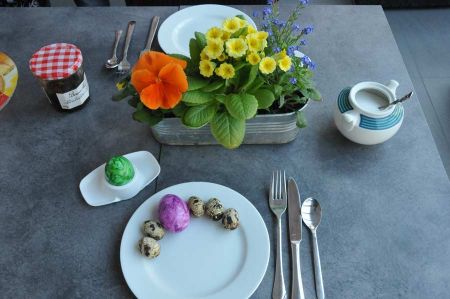Easter time – egg time - chicken and quail eggs!
- Written by Portal Editor
We arrived in the south of Germany in time for Easter, where on Good Friday we had already informed ourselves extensively about the custom in Franconia of decorating the village wells with pine greens and blown out and then hand-painted eggs.
So, it was logical that for breakfast the following morning, in addition to the freshly boiled, soft breakfast egg, there was also a hand-painted, hard-boiled egg on the breakfast plate. Next to them, however, were a few miniature eggs that could be clearly identified as quail eggs due to their natural colouring. We had heard about quail eggs several times, but we had never been served quail eggs for breakfast.
However, the taste of the quail eggs is much more intense
 Quails are one of the smallest members of the group of chicken birds, so their eggs, weighing only 10 - 12 grams, are significantly smaller than chicken eggs, which are around 5 - 6 times as heavy. In the past, quail eggs were painstakingly collected by collectors because of their excellent camouflage color in nature. Today, quail eggs have long been produced on quail farms as an agricultural product in food production. Among gourmets, quail eggs are considered a delicacy that can be prepared and used like regular chicken eggs. As we find out a little later, the taste of quail eggs is much more intense than that of chicken eggs. Even in ancient Egypt 3,000 years ago, quail eggs were already highly valued as a delicacy and medicine.
Quails are one of the smallest members of the group of chicken birds, so their eggs, weighing only 10 - 12 grams, are significantly smaller than chicken eggs, which are around 5 - 6 times as heavy. In the past, quail eggs were painstakingly collected by collectors because of their excellent camouflage color in nature. Today, quail eggs have long been produced on quail farms as an agricultural product in food production. Among gourmets, quail eggs are considered a delicacy that can be prepared and used like regular chicken eggs. As we find out a little later, the taste of quail eggs is much more intense than that of chicken eggs. Even in ancient Egypt 3,000 years ago, quail eggs were already highly valued as a delicacy and medicine.
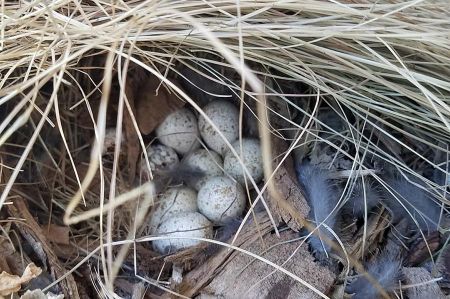 Hildegard von Bingen, Benedictine nun, poet and polymath in the Rupertsberg monastery near Bingen am Rhein, also dealt with the special healing power that is said to be present in quail eggs in her works on religion, medicine, music, ethics and cosmology in the 11th century. In her opinion, quail eggs should strengthen the organism as a whole. Modern, alternative medicine is also based on strengthening the immune system and helping with allergies, especially alleviating hay fever. To date, there is no scientific evidence of this, although numerous studies have since confirmed the effectiveness of quail eggs in various diseases.
Hildegard von Bingen, Benedictine nun, poet and polymath in the Rupertsberg monastery near Bingen am Rhein, also dealt with the special healing power that is said to be present in quail eggs in her works on religion, medicine, music, ethics and cosmology in the 11th century. In her opinion, quail eggs should strengthen the organism as a whole. Modern, alternative medicine is also based on strengthening the immune system and helping with allergies, especially alleviating hay fever. To date, there is no scientific evidence of this, although numerous studies have since confirmed the effectiveness of quail eggs in various diseases.
Further healing effects or positive effects of quail eggs in alternative medicine can be seen:
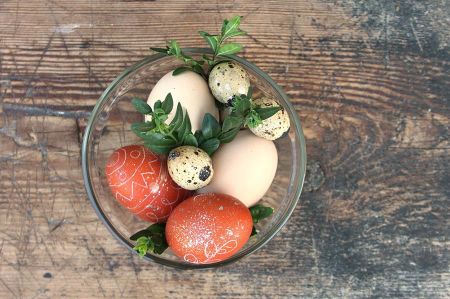 for skin diseases
for skin diseases
in positive effects on blood pressure
for heart and kidney problems
for stomach problems
for asthma, diabetes, neurodermatitis, migraines and digestive problems
to strengthen the immune system
for detoxification and purification
to vitalize the body
However, we were now hungry for breakfast and would rather eat the really excellent tasting quail eggs, which were lightly cracked for this purpose and then simply drained, just like the larger chicken eggs. A delicious delicacy that, as we have learned, is also very healthy.
Dyed “Easter eggs”, even far away from the tourist hotels
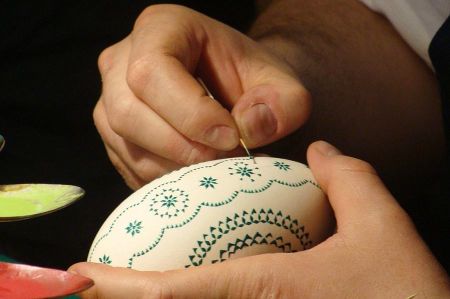 The dyed chicken egg, which was just scooped out and ready to eat in front of us a short time later, was also simply delicious. We had already been told in advance that the eggs were guaranteed to come from neighbourhood chickens that roamed freely in the garden. A true statement according to taste.
The dyed chicken egg, which was just scooped out and ready to eat in front of us a short time later, was also simply delicious. We had already been told in advance that the eggs were guaranteed to come from neighbourhood chickens that roamed freely in the garden. A true statement according to taste.
We were now also interested in the question of why the hard-boiled eggs are coloured at Easter, because the colouring certainly shouldn't and shouldn't change the taste. During our travels we came across dyed “Easter eggs” in many countries in the Mediterranean region, even far away from the tourist hotels. This Christian tradition is even widespread in Armenia and Russia. And almost everywhere in the above-mentioned regions, on the morning of Easter Sunday, children go in search of the brightly painted eggs that had previously been hidden in the garden.
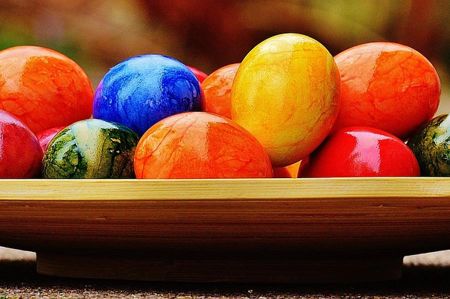 According to science, the Christian Easter festival originally comes from the Jewish Passover festival, and there are a large number of other similarities between Christian, Jewish and Islamic connections. Eggs are also an essential part of the Jewish Seder meal, which is intended to commemorate the exodus of the Jews from Egypt on the eve of Passover in the family or community. However, there is so far no evidence of a connection between the use of eggs at the Seder and Christian Easter customs. We have heard again and again about the symbolic interpretation of the egg since ancient times, but it also appears in other cultures and religions. Dyed eggs are still eaten today during the Nowruz festival in Iran, especially among the Zoroastrian and Yazidi ethnic groups.
According to science, the Christian Easter festival originally comes from the Jewish Passover festival, and there are a large number of other similarities between Christian, Jewish and Islamic connections. Eggs are also an essential part of the Jewish Seder meal, which is intended to commemorate the exodus of the Jews from Egypt on the eve of Passover in the family or community. However, there is so far no evidence of a connection between the use of eggs at the Seder and Christian Easter customs. We have heard again and again about the symbolic interpretation of the egg since ancient times, but it also appears in other cultures and religions. Dyed eggs are still eaten today during the Nowruz festival in Iran, especially among the Zoroastrian and Yazidi ethnic groups.
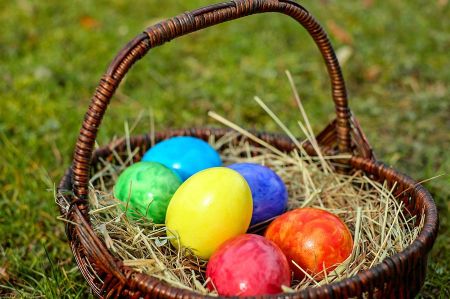 In the Christian faith, as well as in European art history, the egg is considered a symbol of the resurrection, as it is often found in the background of pictures of the Virgin Mary or as a marginal motif in the interpretation of the virgin birth. The following reasons are probably responsible for the custom of giving decorated eggs to friends and acquaintances at Easter:
In the Christian faith, as well as in European art history, the egg is considered a symbol of the resurrection, as it is often found in the background of pictures of the Virgin Mary or as a marginal motif in the interpretation of the virgin birth. The following reasons are probably responsible for the custom of giving decorated eggs to friends and acquaintances at Easter:
As early as the 12th century, food was consecrated at Easter, including the blessing of eggs: “...that they may become wholesome food for your believing servants, who eat them in gratitude and in memory of the Lord's resurrection.”
The tax paid by farmers to their landlords, the so-called tithe, which was paid in the form of eggs on Maundy Thursday in the spring, also points to the great symbolic power of eggs. However, the causal reason here was probably the fasting period, which, at the same time as the hens' increased willingness to lay, led to a surplus of eggs.
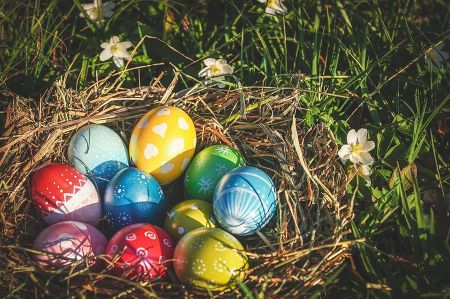 During the 14 days of Lent before Easter, yes, fasting is also deeply rooted in the Christian faith, Orthodox and Catholics abstain from meat and dairy dishes, which often included other animal products such as eggs during abstinence. With Easter, these foods were also received back, blessed too. Adding to the joy was the gifting in coloured and blessed form to friends and acquaintances.
During the 14 days of Lent before Easter, yes, fasting is also deeply rooted in the Christian faith, Orthodox and Catholics abstain from meat and dairy dishes, which often included other animal products such as eggs during abstinence. With Easter, these foods were also received back, blessed too. Adding to the joy was the gifting in coloured and blessed form to friends and acquaintances.
Dyed eggs were mentioned in documents in Germany as early as the 13th century. There are reports from 1553 of red eggs during the Easter consecration of food. The term Easter egg first appears in records from Strasbourg in 1615.
It is a very old tradition to dye eggs colourfully and give them as gifts at Easter.
Happy Easter to all of you.
Please read as well:
George McGavin – former Oxford University entomologist
Amazonia by Yadegar Asisi – Fascination of tropical rainforest
-
 Easter tradition and behaviour in Germany
Easter tradition and behaviour in Germany
Easter tradition and behaviour in Germany
Easter tradition and behaviour in Germany
-
 Easter tradition and behaviour in Germany
Easter tradition and behaviour in Germany
Easter tradition and behaviour in Germany
Easter tradition and behaviour in Germany
-
 Easter tradition and behaviour in Germany
Easter tradition and behaviour in Germany
Easter tradition and behaviour in Germany
Easter tradition and behaviour in Germany
-
 Easter tradition and behaviour in Germany
Easter tradition and behaviour in Germany
Easter tradition and behaviour in Germany
Easter tradition and behaviour in Germany
-
 Easter tradition and behaviour in Germany
Easter tradition and behaviour in Germany
Easter tradition and behaviour in Germany
Easter tradition and behaviour in Germany
-
 Easter tradition and behaviour in Germany
Easter tradition and behaviour in Germany
Easter tradition and behaviour in Germany
Easter tradition and behaviour in Germany
-
 Easter tradition and behaviour in Germany
Easter tradition and behaviour in Germany
Easter tradition and behaviour in Germany
Easter tradition and behaviour in Germany
-
 Easter tradition and behaviour in Germany
Easter tradition and behaviour in Germany
Easter tradition and behaviour in Germany
Easter tradition and behaviour in Germany
-
 Easter tradition and behaviour in Germany
Easter tradition and behaviour in Germany
Easter tradition and behaviour in Germany
Easter tradition and behaviour in Germany
https://www.alaturka.info/en/life/culinary/6513-easter-time-egg-time-chicken-and-quail-eggs#sigProIdd2044dd642
